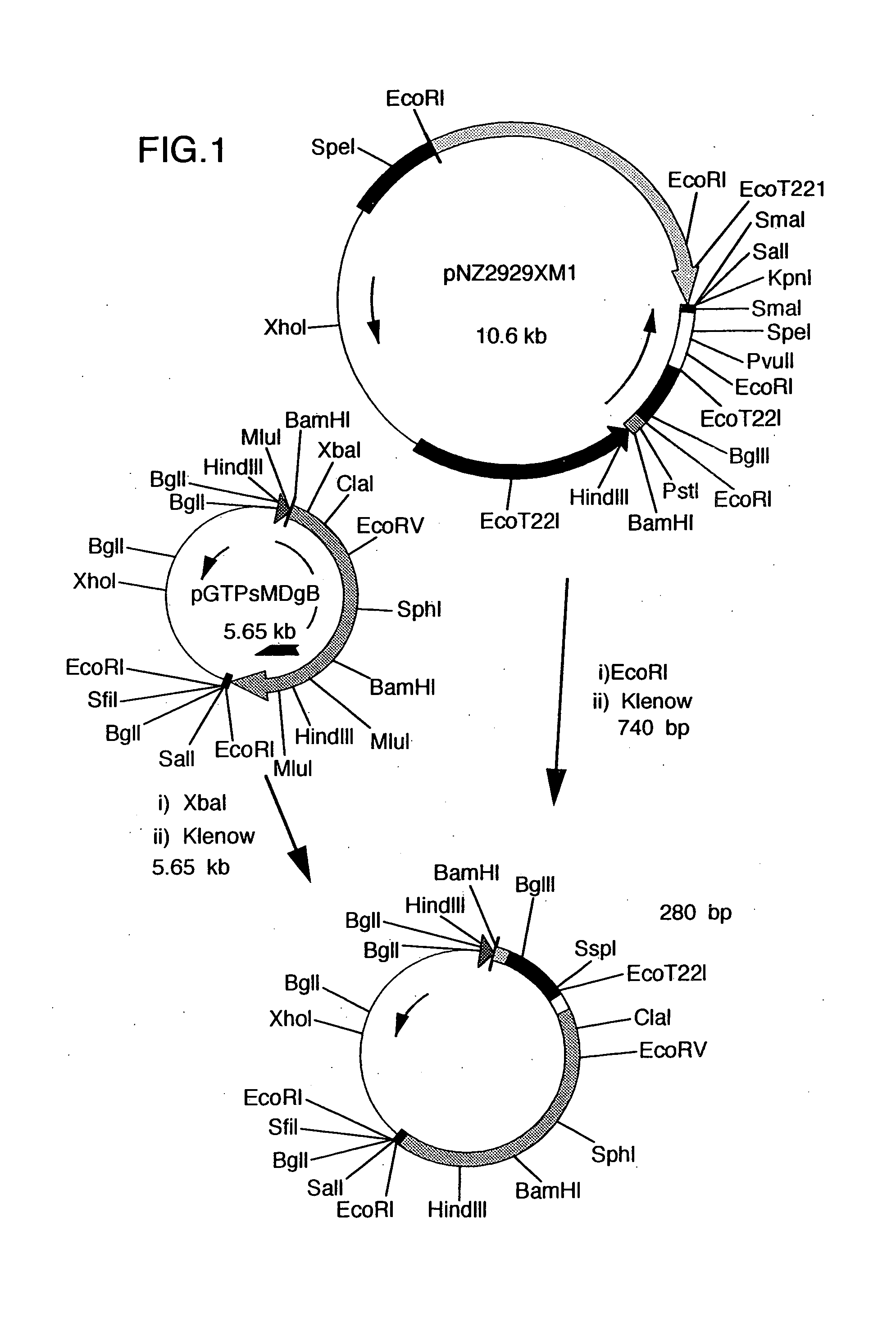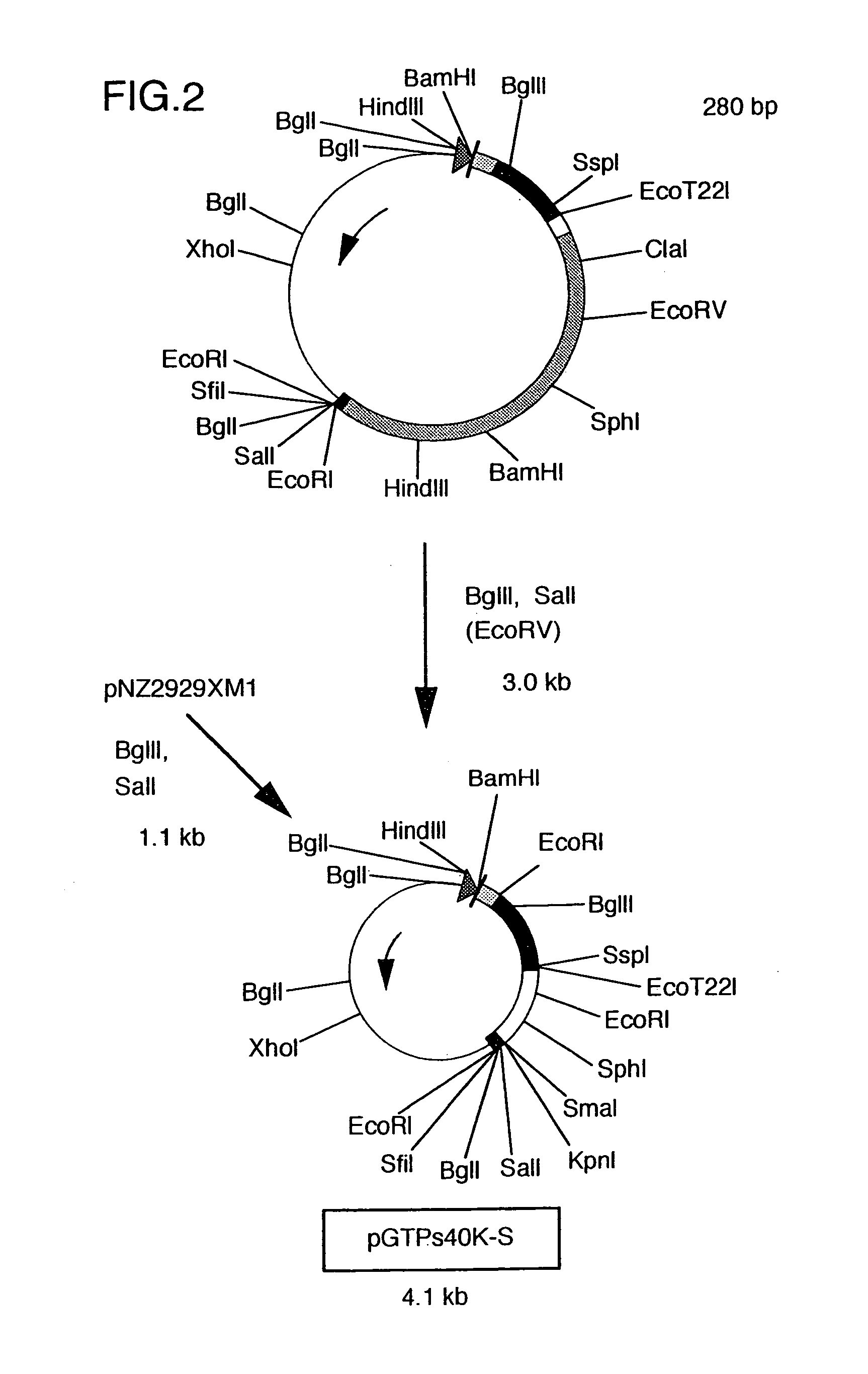Fused protein, gene therefor, recombinant vector, recombinant virus, and its use
a fusion protein and gene technology, applied in the field of new fusion polypeptides, can solve the problems of short immunity duration, complicated inoculation procedures, and large damage done to poultry farming, and achieve the effect of improving the antigen recognition ability of the host and enhancing the infection prevention activity
- Summary
- Abstract
- Description
- Claims
- Application Information
AI Technical Summary
Benefits of technology
Problems solved by technology
Method used
Image
Examples
example 1
Construction of Recombinant pNZ40K-S Bearing Hybrid DNA Ligating TTM-1 Protein DNA Immediately After the Signal of gB Gene for Marek's Disease Virus (cf. FIGS. 1. 2 and 3)
[0050]First, plasmid pUCgB bearing gB gene of Marek's disease virus, disclosed in JPA 6-78764, was digested with restriction enzymes BamHI and SalI to recover a fragment of 3.9 kb.
[0051]Separately, plasmid pGTPs was constructed by digesting plasmid pNZ1729R (Yanagida et al., J. Virol., 66, 1402-1408 (1992)) with HindIII and SalI, inserting the resulting DNA fragment of about 140 bp into pUC18 at the HindIII-SalI site thereof, further inserting synthetic DNA (5′-AGCTGCCCCCCCGGCAAGCTTGCA-3′) SEQ ID NO: 7 at the HindIII-PstI site, then inserting synthetic DNA (5′-TCGACATTTTTATGTGTAC-3′) SEQ ID NO: 8 at the SalI-EcoRI site and finally inserting synthetic DNA (5′-AATCGGCCGGGGGGGCCAGCT-3′) SEQ ID NO: 9 at the SacI-EcoRI site.
[0052]The thus obtained pGTPs was digested with restriction enzymes SalI and BamHI and then ligat...
example 2
Construction of Recombinant pNZ40K-C Bearing Hybrid DNA Ligating TTM-1 Protein DNA at the C Terminus of gB Gene for Marek's Disease Virus (cf. FIGS. 4. 5 and 6)
[0054]After plasmid pGTPsMDgB obtained in Example 1 was digested with restriction enzyme MluI, and then obtained a blunt end with T4 DNA polymerase, which was followed by digestion with restriction enzyme XbaI to recover a fragment of 1.9 kb. Separately, pBluescript II (made by Toyobo Co., Ltd., hereinafter abbreviated as pBSKSII) was digested with restriction enzymes XbaI and SmaI. The resulting fragment was ligated with the 1.9 kb fragment obtained above using a ligase to give a plasmid. The resulting plasmid was digested with restriction enzymes EcoRI and SalI. The resulting fragment was ligated with the 550 bp fragment and the 615 bp fragment, both obtained by digestion of pNZ2929XM1 with restriction enzymes EcoRI and Eco T22I and with restriction enzymes EcoT22I and SalI, respectively, using a ligase to construct a plasm...
example 3
Construction of Recombinants FPV 40K-C and 40K-S and Purification Thereof
[0056]NP strain, which is a fowlpox live vaccine strain, was infected to monolayered CEF at m.o.i.=0.1. Three hours after, these cells were scraped off from the monolayer by a treatment with trypsin to form a cell suspension. After 2×107 cells in the suspension were mixed with 10 μg of plasmid pNZ40K-C or pNZ40K-S for use in recombination, the mixture was suspended in Saline G (0.14 M sodium chloride, 0.5 mM potassium chloride, 1.1 mM disodium hydrogenphosphate, 1.5 mM potassium dihydrogenphosphate, 0.5 mM magnesium chloride hexahydrate, 0.011% glucose). The suspension was subjected to electrophoresis under conditions of 3.0 kV cm−1, 0.4 msec and 25° C., using GENE PULSER (trademark) (manufactured by Bio-Rad Co., Ltd.) at room temperature. The plasmid-infected cells were then cultured at 37° C. for 72 hours. The cells were lysed by freezing and thawing 3 times to recover viruses containing the recombinant virus...
PUM
| Property | Measurement | Unit |
|---|---|---|
| temperature | aaaaa | aaaaa |
| temperature | aaaaa | aaaaa |
| concentration | aaaaa | aaaaa |
Abstract
Description
Claims
Application Information
 Login to View More
Login to View More - R&D
- Intellectual Property
- Life Sciences
- Materials
- Tech Scout
- Unparalleled Data Quality
- Higher Quality Content
- 60% Fewer Hallucinations
Browse by: Latest US Patents, China's latest patents, Technical Efficacy Thesaurus, Application Domain, Technology Topic, Popular Technical Reports.
© 2025 PatSnap. All rights reserved.Legal|Privacy policy|Modern Slavery Act Transparency Statement|Sitemap|About US| Contact US: help@patsnap.com



